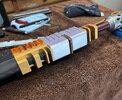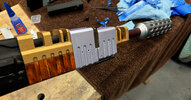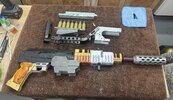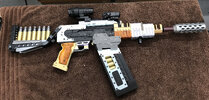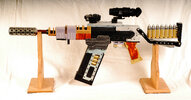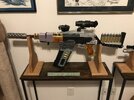Some more progress while I wait on the final steps from recovering from some buffoonery on my part ...
First came when I was attempting to attach the shell carrier to the carrier rail. To ensure the best possible bond you always want to have bare plastic to plastic for CA glue. After removing a painted area to make the bond while test fitting i saw that a part of the rail would be exposed that I didn't think would be and so i had to re prime, re paint & re clear that piece. The 2nd came when i was doing the same thing for the magazine and after exposing a nice edge of bare plastic on the top I realized it wasn't the top but the bottom! So then I had to mask that area, re prime, re sand, re paint & re clear that. All that is done now & tomorrow I can re clear each piece and get on with final assembly ...

